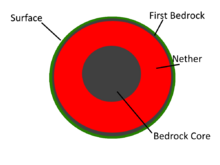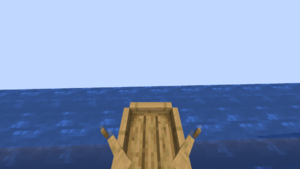Terra Nova (Planet)
The Blue Marble / Terra - Planet Terra Nova (name of Earth on EarthMC); the only explored and confirmed planet (Moon is not a planet) in the Sol System.
Inhabited by around 1 000 000 players.
History
We don't know when the universe was created, but the first humans (players) appeared on Terra on October 19th, 2018 (IRL Calendar, In-Game Calendar - year 0)
Exploration
The first nation established on Terra Nova was Britain. Throughout all of the generations of people, we have discovered every spot on the planet.
Dynmap
This invention is critical in the continued expansion of nations and human settlements. The Dynmap also plays a huge role in monitoring conflicts - everyone has access to movements of other people on the surface, (the only exception is invisibility potion utilization).
One day, Fix, the god of EarthMC, created a map of the world, thus ushering in a new era of prospect.
Map projection
You may wonder - how can a square-terrained world be a sphere if it is physically impossible to project a globe onto a flat dyn map? Well, I have a theory. The world itself grows bigger toward the poles (because of the 20-minute day warping the shape) so when projected onto a flat map, the squares would look relatively the same shape.
If this is so, why doesn't it feel bigger if you travel there? Well, since you are further from the core, your body can strech further, thus, you don't feel the difference.
Space Exploration
There were many space programs like the program "Kazakhstan" which first took a photo of Terra Nova from space but it wasn't colored. On the first of May 2020, the BSSA (Baltic States Space Agency) reports having launched a satellite to space and taken the first colored photo of Terra Nova - the same image shown in the infobox.
Although unconfirmed, despite a program under Kazakhstan is likely to have been capable of taking a colored photo; no image has been published yet.
Geography
There are seven continents on Terra: North America, South America, Europe, Asia, Africa, Australia and Antarctica (some people consider Australia as Oceania)
All nations on the globe (registered on EarthMC wiki)
All towns on the globe (registered on EarthMC wiki)
All political systems (registered on EarthMC wiki)
Religions
All religions on the server (registered on EarthMC wiki)
Physical Information:
How to calculate mass?
1 block of stone (the most common block throughout Terra Nova) has a mass around 1.8 metric tons. We count the map as a square 66000 blocks x 66 000 blocks across.
66,000 x 66,000 = 4 356 000 000 blocks on surface.
4 356 000 000 x 1800 kilograms (1.8 tons) = 7 840 800 000 000
7 840 800 000 000 x 60 (depth of map) = 470 448 000 000 000 tons (all blocks, of course approximately)
Atmosphere
There is no mesosphere e.t.c.
The atmosphere of Terra has 3 parts: the Groundsphere, Litosphere and RAS.
The groundsphere has a pressure equal to 1 bar. It forms within 0-256 blocks above bedrock.
The Litosphere has a pressure of around 0.5 bars and it's really hot. You can't place anything above 256 - everything will melt. This sphere is often called the "Build Limit". It forms within 257-512 blocks above bedrock.
The RAS or exosphere (Rare Atmosphere Sphere) is the hottest atmosphere zone. Here pressure starts from 0.5 bars and drops with height. It forms within 513 to 700 blocks of bedrock.
The exosphere is the last of Terra's zones. Space begins here.
We can also count the Nethesphere because the nether has his own Atmosphere (Nether is under the Overworld).
Geological Layers
Theory 1:
Three layers of bedrock, a nigh indestructible material can be found throughout the environments available to research. First and foremost is the layer at the base of Terra Nova's geological surface layer, but two more can be found at the nether's ceiling and bottom. Logically, these layers of bedrock could be attributed to one another, but numerous problems arise from this notion.
There is the problem with how matter is "restricted". While the surface is clearly restricted to a finite space always visible to the Dynmap, the nether has neither of these qualities.
Reports have also described the ability to "ascend" onto the nether's roof layer, which, assuming these reports are accurate, would make it impossible that the nether's roof layer was the same as Terra Nova's base layer of bedrock.
From these two criteria, some concepts have arisen.
- The nether and Terra Nova surface (and rest of the planet as a whole) are fundamentally separate regions. The nether exists somewhere else entirely. Exotic ideas of its location can arise from this, including Sol and Luna.
- The nether and Terra Nova surface are connected, but exist as two separate spheres, one contained within the other. A void occupies the space between the roof of the nether and the base of Terra Nova's surface. The only qualm with this concept is that a solution would need to be found as to why the nether seems nigh infinite, but surface finite.
Theory 2:
When you dig to bedrock, what is under it?
Well, the core of the planet - the Nether.
On top of the Nether, there is also bedrock.
But when you dig to bottom of the nether there is bedrock again.
That's because underneath the Nether there is a bedrock layer - the core of our planet.
Pacific Gap
When you go to "edge" of dynmap you will see... well just the edge. So how can Earth be round? When satelites like Baltica were photographing Terra, they recorded a black gap on Pacific Ocean (also, Kazakhstan captured it too but they thought that its camera mistake so they deleted it) It stretches form pole to pole. It streches into the core of the planet (it cuts nether in half). Here, air from Groundsphere comes into the ground (and (if theory 1 concept 2 were true) this would explain why you can see the sky in the void).
If you happen to fall in the hole, the air will push you towards Africa, the grographical center of the world. The air carries you at a rate so fast you barely notice it. This is the same concept when you do "/t spawn" or "/n spawn". This would also explain why when you "teleport" it appears like you are falling through the sky.
Polar holes
If you go to either of the poles, the same thing will happen - you will see a giant gap. It feels like the gap goes on left and right, but you are actually just going in a circle. Light refraction (due to air passing in) warps your perspective of space, and the hole being big itself helps this illusion. When the holes and gap meet, it looks like a corner. This is because the hole's curvature makes it look like a 90 degree angle. Despite all of that, some pictures just fill the hole in with ocean or ice.
Luna (Moon)
There is a separate article about Luna
Luna (Moon) - the only natural satellite on Terra. Closest cosmic object to Earth; no physical contact has been achieved by humanity. It is in unison with the sun, so when it is day, you can't see the moon (and vice versa).
When we see it, we see a square, but it is probably not a square.
Illusion
We don't see the shape of Luna correctly because of the render distance on EarthMC. We just see the "top" - the closest surface of the Moon.
The best example is when you stand on a very tall tower and look down. You can see a small square - a piece of Terra. Same with Luna's top.

